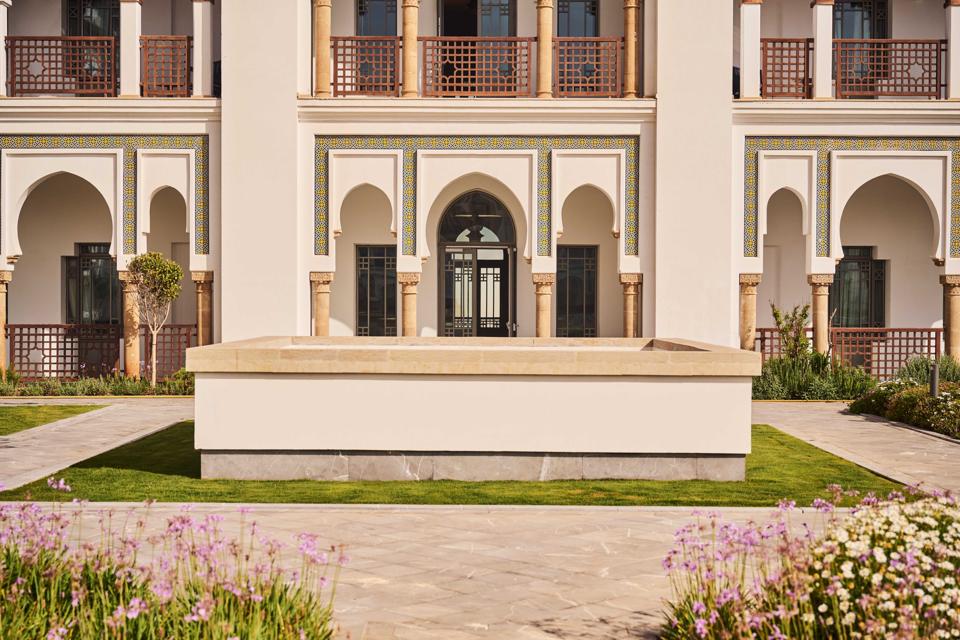“Why not Marrakech?”
So came the repeated response when people heard that my first trip to Morocco would have me spending most of my time in Rabat and not in the country’s biggest tourist draw. Which is precisely the point: Marrakech is Marrakech—everyone knows and loves the place—but what about less-hyped Rabat, Morocco’s quieter, culture-fueled, coastal capital city?
News of several grand developments slated for completion in Rabat soon—the Mohammed VI Tower, a mixed-use skyscraper set to house two luxury hotels and more; the ultra-modern Grand Theatre, designed by Zaha Hadid as the anchor of a new waterfront district—further piqued my interest; learning that a Four Seasons has recently opened there sealed the deal. I checked in for a few days and fell madly in love with both the property and its home city—so much so that I hereby nominate it as a stellar setting for the next season of White Lotus, the hit show anchored in the Four Seasons brand. Here’s what won my heart.
SLEEP When you stay in a slice of history, your stay becomes more than a stay—it’s a full-on experience. Perched on the rocky edge of the Atlantic coastline, the Four Seasons Hotel Rabat at Kasr Al Bahr, meaning “Palace by the Sea,” was the summer residence of Sultan Moulay Slimane, built in the late 18th century. The 12-acre property later served as a military hospital and is now reimagined in brilliant past-meets-present style, with 11 buildings—six historic and five newly built—housing 200 sumptuous rooms, including 40 suites.
I relished wandering through arched corridors and manicured gardens of lavender and palm trees, past fountained courtyards and domed rooftops, all in classic Moorish design. The craftsmanship dazzles—hand-cut Zellige tiles, stained glass windows, warm brass and copper details, marble and rich wood—while contemporary art at every turn playfully lands time-traveling guests right back in the 21st century.
Three standouts left a special mark. The sultan’s 1879 reception hall will soon reopen as a cigar bar, offering rare cognacs, smooth jazz and, well, centuries of luxe atmosphere. The Sultan’s Riad Suite, in the sultan’s original residence, spans two floors, boasts sweeping Atlantic views from its terrace and, like the whole property, exudes majestic beauty. And sunsets from the pool deck are so sublime they are worth arranging your entire day around.
DO It’s a shame I loved the hotel so much; Rabat beckons with plenty of reasons to get off property. I took a day tour to pack in as much of the city’s history and beauty as possible—while still making it back for precious lounging-by-the-pool time. It’s tough to not turn camera happy at the Hassan Tower and Mausoleum of Mohammed V, a complex of gorgeous ruins featuring a 12th century minaret; even more so at the picturesque Kasbah des Oudaias, a fortress built in the 12th century that’s now a fairy tale-like village of homes and gardens, and the Chellah, a 14th-century necropolis and historic site where Roman ruins merge with Islamic architecture. Shop for local Argan oil products, carpets, jewelry and all things Moroccan in the narrow streets of the Medina, Rabat’s charming old city.
With more than 500 acres of parks and green spaces, Rabat is feted as a serene city of gardens; some, like the lush Andalusian Gardens, go back centuries and others, like the pretty greenery of the Embassy District, home to consulates and embassies, more contemporary. Speaking of contemporary, art lovers will want to stop in at the stellar Museum of Modern and Contemporary Art (MMVI) and the National Photography Museum, set in an ancient fortress right next door to the Four Seasons.
And because I couldn’t visit Morocco without laying eyes on at least two cities—I vow to return soon for more!—I had the hotel coordinate a day trip to Fez via Pure Morocco Tours. With all that history, Fez demands a guide; mine was hyper-knowledgable and just plain hyper, leading me rapid-fire from the teeming, winding, unforgettable streets of the Medina—past camel heads and handmade leather and all manner of culinary delights—into the world’s first university, stunning palaces and finally the old Jewish quarter. During the beautiful ride back to Rabat, the sun set across the sands of North Africa and I affirmed that each city in Morocco is on its own worth getting on a plane for.
EAT This part really belongs under the “Do” category, because eating in Morocco is a delectable activity unto itself. Four Seasons Rabat knows this. At Flamme, the highlight is all things local: For lunch order off the “Moroccan menu” and enjoy couscous, myriad tagines (the lobster one was divine) and tasty zaalouk (spicy eggplant dip); the elaborate breakfast spread there introduced me to handmade msemen, a pancake-like flaky bread, perfect for dipping in either thick harira soup, made with lentils, or the white-bean bissara soup, drizzled with cumin.
For something completely different, feast on mediterranean dishes like lobster salad, seafood pasta, fresh burrata and sirloin with foie gras at Verdello, where two terraces offer views of the palatial property lit up under the night sky. I also sipped a sriracha spice cocktail at the very sexy Bar Atlantique and, of course, Moroccan mint tea in the Lobby Lounge, where I also discovered the joy of Moroccan sweets like ghriba, made with almond flour and my new favorite cookie.
SPA For me, the best part of the Four Season Rabat’s spa was not its exquisite traditional hammam, or its beautiful indoor pool, nor even its excellent offerings: massages and facials using Argan oil and products by Marocmaroc and Omorovicza (a Budapest brand I was thrilled to snatch up samples of). It was actually the gym, where I worked off my jet lag while simultaneously wave watching—what a view of the frothy sea!—and people watching; the shoreline is a popular sunrise and sunset space for locals to run, walk and greet each other–making me feel not like a hotel guest, but part of the beautiful local community.

